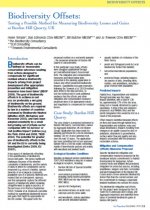Biodiversity Offsets
Testing a Possible Method for Measuring Biodiversity Losses and Gains at Bardon Hill Quarry, UK
By Helen Temple, Bob Edmonds, Bill Butcher, Jo Treweek - The Biodiversity Consultancy, SLR Consulting, Treweek Environmental Consultants, Treweek Environmental Consultants View PublicationIntroduction
Biodiversity offsets can be
defined as ‘measurable
conservation outcomes resulting
from actions designed to
compensate for significant
residual adverse biodiversity
impacts arising from project
development after appropriate
prevention and mitigation
measures have been taken’ (BBOP
2009). The goal of biodiversity
offsets is to achieve no net
loss (or preferably a net gain)
of biodiversity on the ground.
Biodiversity offsets are required
by law in a number of countries
(reviewed by Biodiversity Neutral
Initiative 2005, McKenney and
Kiesecker 2010), and have been
adopted voluntarily by a small
but growing set of private sector
companies with ‘no net loss’ or
‘net positive impact’ policies (e.g.
Rio Tinto 2004 and 2008, TEEB
2010). The potential for greater
use of biodiversity offsets in the
UK and the EU is currently being
investigated.
Case Study: Bardon Hill
Quarry
The case study is a proposed extension to
Bardon Hill Quarry, Leicestershire, owned
by Aggregate Industries UK Ltd (Holcim
Group). Application has been made for
planning permission for a 66 ha extension,
yielding 130 mT of pre-Cambrian rock
over the next 50 years. The application
has been submitted but not yet approved.
Bardon Hill is a 500 ha estate consisting
mainly of low-intensity pasture and arable,
with woodland and lowland heath.

